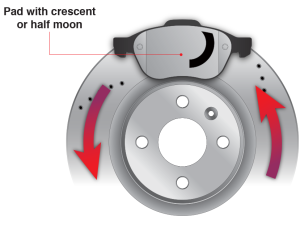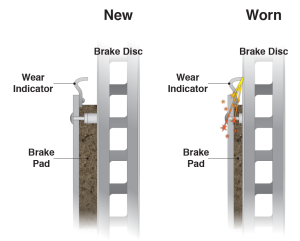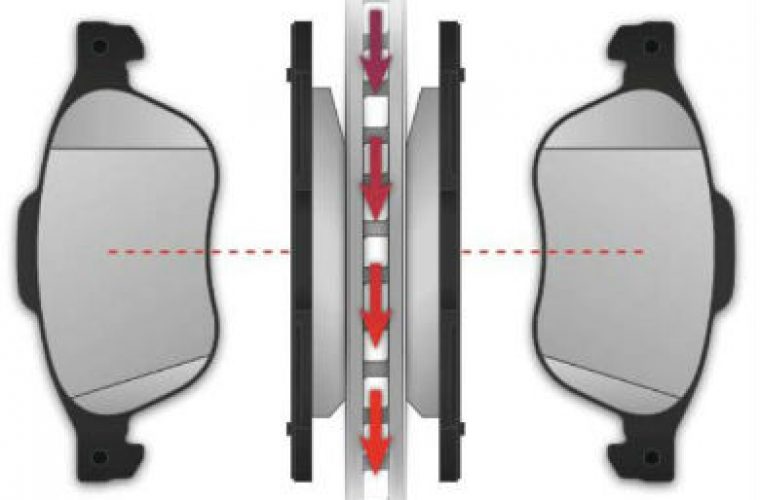In a new technical bulletin Apec has said that technicians should take a few minutes to properly inspect both the pads being removed as well as the new pads intended for fitting for clues as to their orientation as “it is ultimately the technician or garage that will suffer as a result.”
Therefore it makes perfect sense for technicians to take a few minutes to properly inspect both the pads being removed as well as the new pads intended for fitting for clues as to their orientation.
Apec said: “Wrongly fitted parts lead to unhappy customers, the loss of a service bay and a technician who has to first diagnose the issue, and subsequently fix it.
Directional brake pads differ from a traditional brake pad in their form, so measures need to be taken by fitters and technicians in order to minimise fitting issues and the knock on effects to that vehicle’s performance and to the customer.
Apec say it is garages that pay the ultimate penalty when parts are fitted incorrectly, and as such education is key for independent garages looking to minimise customer dissatisfaction.
However, there is not a conventional way a directional pad operates as manufacturers have various methods.![]()
Chamfer
Apec explain: “Standard brake pads can be ‘pulled’ by the brake disc on application, which can lead to damage as well as poor braking performance and uneven wear.
“Chamfers offer a transitional edge between two vertices of an object and will likely be present on the leading edge of a brake pad, or on both edges of the pad.
“In general chamfers are angled anywhere up to 45 degrees and serve three main purposes; to induce even pad wear, to prevent the leading edge of the brake pad lifting and being pulled away by the brake disc and to reduce noise.
“When installing brake pads with chamfers fitters need to keep en eye out for the angular edge of the friction material.
“If there is no arrow on the back of the pad and there is only one chamfer, then that chamfer needs to be presented at the leading edge where the pad first contacts the brake disc.”![]()
Shims
“Almost all brake squeal is caused by oscillation between pads, caliper and discs.
“Through rigorous research and development, Apec Braking is able to manufacture shims that are fixed or clip-on to the rear of each brake pad, helping to locate it correctly within the caliper.
“Brake shims prevent and reduce the transmission and amplitude of vibrational forces or brake chatter, which is achieved with dampening material bonded to the pad assembly.
“Shims also add mass to the brake system, dampening vibration in the pad and calliper.
“Finally shims can also act as a thermal barrier to ensure even temperatures across the pad, which translates into more consistent braking.![]()
Shims with crescent cut-out
 “Fitters need to be aware that some shims may have a crescent or half moon cut out present, which allows the piston to push the brake pad at a desired angle, reducing noise and creating more unified and even pad wear.
“Fitters need to be aware that some shims may have a crescent or half moon cut out present, which allows the piston to push the brake pad at a desired angle, reducing noise and creating more unified and even pad wear.
“If this type of pad is fitted in the opposing direction then you are highly likely to experience noise as the leading edge will contact the disc first, causing chatter, heard by the fitter or customer as a high pitch squeal.![]()
Directional/wear indicators
 “Many brake pads will feature wear indicators, these can be sophisticated and run electronically so best practice is to look at how the previous indicator was plugged-in.
“Many brake pads will feature wear indicators, these can be sophisticated and run electronically so best practice is to look at how the previous indicator was plugged-in.
“It is likely that a directional pad featuring an electronic indicator will only fit correctly in one direction.
“More commonly brake pads feature a simple metal hook that “screeches’ on contact with the brake disc.
“It should feature on the leading edge, so the indicator makes contact with the disc before the pad.
“If these pads are installed the wrong way round the indicator will not sound correctly and thus customers may increase the likelihood of damaging the brake disc as they run their pads below the minimum threshold.
For further information, call Apec’s technical support team on 01454 324644 or follow the ‘more details’ link below.







